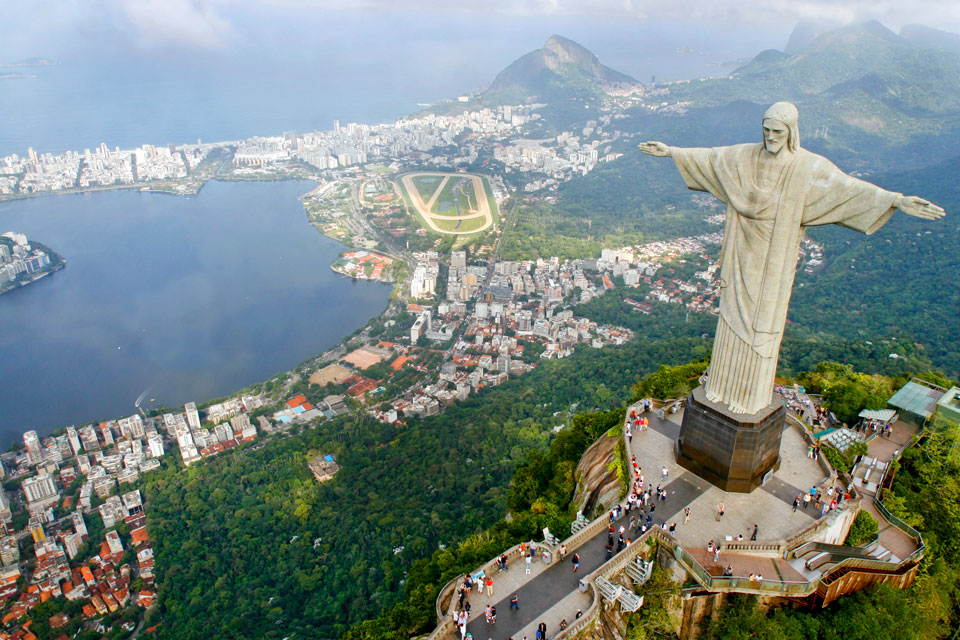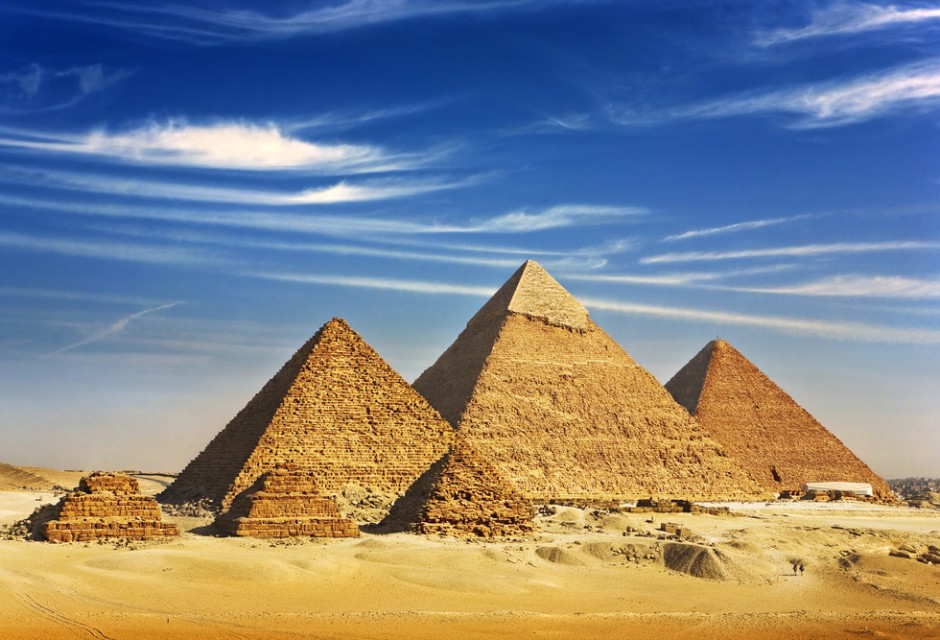1. Machu Picchu
Machu Picchu, Peru

Machu Picchu is a 15th-century Incan citadel nested high in the Andes Mountains in the middle of a tropical forest in Peru (2,430 meters above sea-level) northwest of Cuzco and through which the Urubamba River flows. It is the most familiar icon of Inca civilization that was built around 1450 and was forgotten until the early part of the 20th century. Most of the buildings have been reconstructed in order to show tourists how they originally appeared. Today the Inca Trail winds through the mountains and along the path of the ancient royal highway.
2. The Great Wall
Mutianyu, Beijing, China
The Great Wall of China is the longest wall in the world made of stone, soil, sand, brick, wood and other materials. It generally built along the historical northern borders of China to protect the country against invasions of the various nomadic groups of the Eurasian Steppe. Several walls were being built as early as the 7th century B.C., later joined together and made bigger and stronger, are now collectively called as the Great Wall. Especially famous is the wall built 220–206 B.C. by Qin Shi Huang, the first Emperor of China. Since then, the Great Wall was rebuilt, maintained, and enhanced. In the Han Dynasty, the emperors extended the Great Wall far into today’s western China to protect Silk Road trade. Due to natural erosion and human damage, about 30% of the Ming Great Wall has disappeared.
3. Chichen Itza
Yucatan, Mexico

Chichén Itzá which means “at the mouth of the well of Itza” is located on Mexico’s Yucatán Peninsula between Valladolid and Merida, and it is a world-famous complex of Mayan ruins. Several buildings have survived, such as the Warriors’ Temple, El Castillo and the circular observatory El Caracol. While the earliest archaeological artifacts thus far found at Chichen Itza dated from AD 1 to 250, it is possible that the site was built much earlier. El Castillo (the castle) or The Kukulcán Pyramid, is one of the new seven wonders of the world, is exactly 24 m. high considering the upper platform. The Yucatan Peninsula where Chichen Itza is located has no rivers or streams. The region is pockmarked with natural sinkholes, called cenotes, which expose the water table to the surface.
4. Taj Mahal
Agra, India

The Taj Mahal is a shimmering white marble mausoleum located on the right bank of the Yamuna River in a vast Mughal garden in the Indian city of Agra. It built between 1631 and 1648 by order of the Mughal emperor Shah Jahan in memory of his favorite wife, Mumtaz Mahal. The Taj Mahal is the jewel of Muslim art in India and one of the internationally admired masterpieces of the world’s heritage. The color combination of lush green scape reddish pathway and blue sky over it showcases the monument, and it’s color even changes depending on the sunlight or moonlight hitting its surface.
5. Christ the Redeemer
Rio de Janeiro, Brazil

Christ the Redeemer (Cristo Redentor) is an Art Deco-style colossal statue of Jesus Christ at the summit of Mount Corcovado in the Tijuca Forest National Park overlooking the city of Rio de Janeiro, Brazil. It was constructed between 1922 and 1931, and weighs 635 tons, stands 30 meters tall, its horizontally outstretched arms spanning 28 meters. A symbol of Christianity across the world, the statue is a cultural icon and one of Rio de Janeiro’s most recognizable landmarks. It is listed as one of the New 7 Wonders of the World.
6. Angkor Wat
Siem Reap, Cambodia

Angkor Wat is a temple complex in Cambodia built by Suryavarman II (r 1112–52), and the largest religious monument in the world. The temple is the heart and soul of Cambodia, a source of national pride and one of the most important archaeological sites in South-East Asia. Unlike the other Angkor monuments, it was never abandoned and has been in continuous use since it was built. Stretching over approximately 400 square kilometers, including forested area, Angkor Archaeological Park contains the magnificent remains of the different capitals of the Khmer Empire, from the 9th to the 15th century. Temples such as Angkor Wat, the Bayon, Preah Khan and Ta Prohm, exemplars of Khmer architecture, are closely linked to their geographical context as well as being imbued with symbolic significance.
7. The Grand Canyon
Arizona, USA

The Grand Canyon is a steep-sided canyon carved by the Colorado River in the state of Arizona in the United States . It is 446 km long, up to 29 km wide and over 1,9 km deep. For many thousands of years, the area has been inhabited by Native Americans. They built settlements within the canyon and its many caves. Around 5 million people see the Grand Canyon every year. Most visitors see it from the “South Rim”with an easy access by free park shuttle buses or by personal vehicles. South, North and West Rims of the Grand Canyon offer quite different experiences and, as they lie hundreds of kilometers and hours of driving apart, are most often visited on the separate trips.
8. Uluru
Northern Territory, Australia

Uluru, or also known as Ayers Rock, is a spectacular red sandstone monolith in the heart of Australia rising out of the Central Australian desert at the Northern Territory 450 km from the nearest large town, Alice Springs. Uluru is considered one of the world’s great natural wonders and one of Australia’s most recognizable natural icons. It’s sacred part of Aboriginal creation mythology and is about 700 million years old. The area around the rock is home to an abundance of springs, waterholes, caves, and ancient paintings.
9. Pyramids of Giza
Giza, Egypt

The Great Pyramid of Giza (also spelled Gizeh) is the oldest and largest of the three pyramids (Khufu, Khafre and Menkaure) in the Giza pyramid complex in Egypt. The names of the pyramids referred to the kings for whom they were built. It is the oldest of the 7 Wonders of the World, and the only one to remain largely intact. Egyptologists say that the Great Pyramid was built over a ten to twenty year period around 2560 BC. Initially at 146.5 meters, it was the tallest man-made structure in the world for more than 3,800 years. Originally, the Great Pyramid was covered by casing stones that formed a smooth outer surface; what is seen today is the underlying core structure.
10. Mount Fuji
Honshu Island, Japan

Mount Fuji is an active nearly perfectly shaped volcano about 100 km southwest of Tokyo, which most recently erupted in 1708. It is with 3776 meters Japan’s highest mountain and the focal point of the Fuji-Hakone-Izu National Park. Visible from Tokyo on a clear day, the mountain is located on the border between Yamanashi and Shizuoka Prefectures and can be seen from Tokyo and Yokohama on clear days. It is not surprising that the volcano has been worshiped as a sacred mountain and experienced big popularity among artists and common people throughout the centuries. Its iconic profile is the subject of numerous works of art.
Read more:
